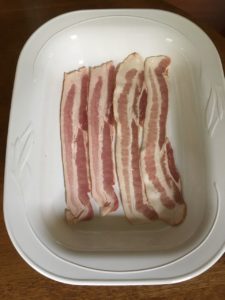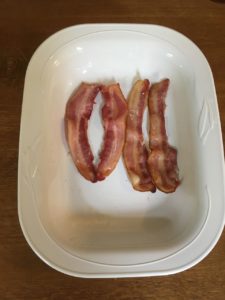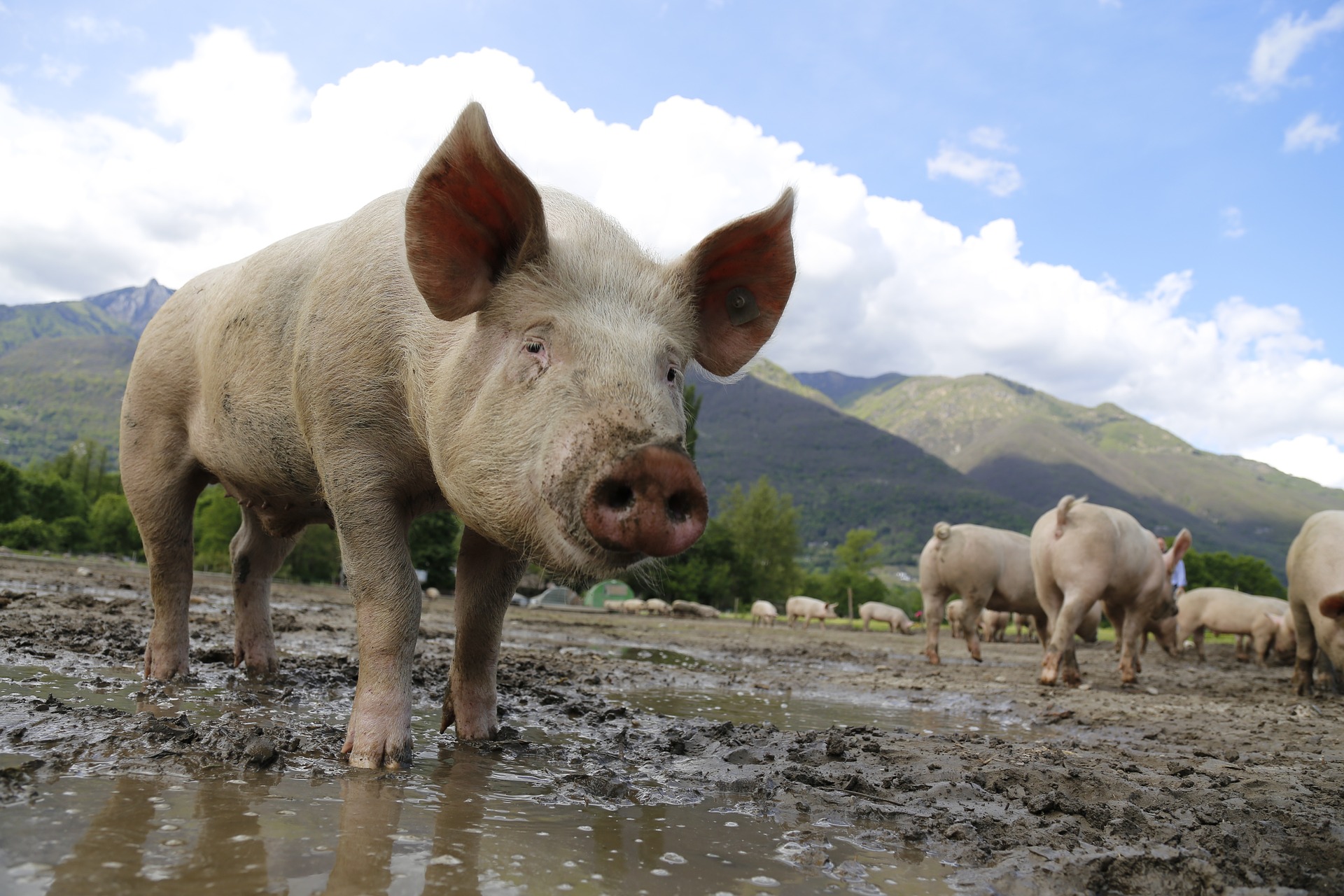Many people like bacon. More than like milk, or country and western music, or Donald Trump. According to the website Statista, in 2018 more than 80% of Americans said that they eat it, and 18% say they don’t (1.8% aren’t sure; say what?). As an unreconstructed omnivore (I’m trying, vegans, I’m trying) I too eat bacon on occasion. And being analytically compulsive, I’m curious — how many calories does it contain? In particular, “side bacon”, the kind most people eat (even Canadians eat mostly side bacon).
Of course, there is no exact answer to the question of side bacon’s calorie content. It depends on the source of the bacon (pig, yes, but how chubby a porker?). It also depends on how it’s prepared. I don’t think anybody eats it raw, but beyond that, preferences may vary, from softly fatty to shatteringly crisp. The more it’s fried, the more calories are shed. But even a good ballpark figure is not easy to come by.
What does the internet say about the calories in bacon?
The internet has a baffling variety of answers to the question of how many calories are in bacon. Here are some examples.
‑— Begin with Wikipedia, which is often my first stop for information. According to the Wiki, one rasher (slice) of bacon, cooked to “streaky” appearance, weighs 20 grams, provides 66 kcal (the abbreviation of ‘kilocalorie’, the scientific term for 1,000 calories), and 73% of these calories are from fat. That doesn’t help much, because it doesn’t tell us how big the slice was to begin with — was it thin cut or thick?
— The “Fitbit” site gives very confusing information. One page you get if you Google “Fitbit bacon calories” claims that 1 slice of thick bacon, fried, provides 42 kcal, none of these from fat! But it then gives a value of 29 grams of fat, which would contain about 260 kcal. On another Fitbit page, you learn that a serving of 2 slices of cooked bacon contains 70 kcal, with 50 of these coming from fat. That’s not unreasonable for very thin, short slices. But then, on the same page, a serving of 13 grams of cooked bacon provides those same values — 70 kcal total, 50 from fat. That’s 71% from fat. Wiki gives a value of 66 kcal per slice, Fitbit only 35.
— The “Myfitnesspal” site provides two values for the kcal in a slice of bacon, 37 and 45, with fat accounting for 68% of the total.
At least the “Calories from fat” values are similar for all 3 sources of information, but are they correct, given the wide variation in total calories per slice?
I could have continued the internet hunt, but with such differences, what would be the point? So I decided to determine the values myself. I did a little experiment. Actually, I did it four times, with 3 different sources of store-bought side bacon.
The experiment
Measuring the calories in bacon is a matter of finding out how much fat and protein are in there. I thought the most useful numbers would be for 100 grams of raw bacon, which you can then scale to a value per slice. For example, a one-pound package of bacon that has 12 slices contains 38 grams per slice. I used three different kinds of bacon, purchased in three different supermarkets, to get a representative picture.

First, I fried them to the degree of done-ness I like to eat.

Then I analyzed those cooked slices. I put them into a little aluminum tray and baked them in the oven at 350º. Every half hour I would weigh the bacon, until it no longer changed (this took an hour). Heating bacon for a long time “renders” the fat; it runs off and collects as pure fat on the bottom of the tray. What’s left of the original bacon has two components. The meat is present in dark brown strips, but so are some lighter-coloured streaks, corresponding to those seen in Figure 2. These streaks are “cracklings”, or “scratchings”. They contain both protein and a form of fat tightly associated with it, which doesn’t render.
Cracklings are a favoured snack in many cultures (they go well with beer). The Internet provided some guidance as to the calorie content of cracklings. Based on that information, I used a value of 6 kcal per gram. I assigned the usual 4 kcal and 9 kcal per gram for pure protein and fat, respectively.
The results
First off, a lot of the raw bacon, 53% by weight, was water. There’s even a fair amount of water in the fried bacon (Figure 2) — about 30% by weight. To compare results most easily, I calculated everything per 100 grams of raw starting bacon. The results for four preparations of fried, ready to eat bacon, were as follows.
Grams per 100 grams of raw starting bacon
Run Fat Crackling Meat
A 4.3 10.7 13.9
B 3.3 9.3 12.4
C 4.0 8.5 11.6
D 4.4 9.2 13.8
Average: 4.0 9.4 12.9
Kilocalories: 36 56.4 51.6
Total Kilocalories: 144
Fat calories: 41%
The average calorie content for these samples of cooked bacon, representing three different brands and not differing much from each other, was 144 kcal per 100 grams of raw bacon.
The average slice weighed 49 grams before cooking, and yielded cooked bacon with 71 kcal per slice.
The average slice weighed just 16 grams after cooking, for an average energy content of the bacon as eaten of 4.4 kcal per gram, if you want to do the calculation that way.
The cooked bacon contained about 41% of its calories in fat (present in the fat itself, and as part of the cracklings). The streaks of meat, and the meat present in the cracklings, contained the rest.
Caveats about eating a lot of bacon
Although the fat content isn’t excessive, it is almost entirely saturated fat, the kind nutritionists say we shouldn’t get too much of. And there’s quite a lot of salt as well, and then you might also worry about the nitrites used in curing bacon. Moderation in all things, even bacon, would seem to be indicated.
Bon appetit.
Go To Contents




